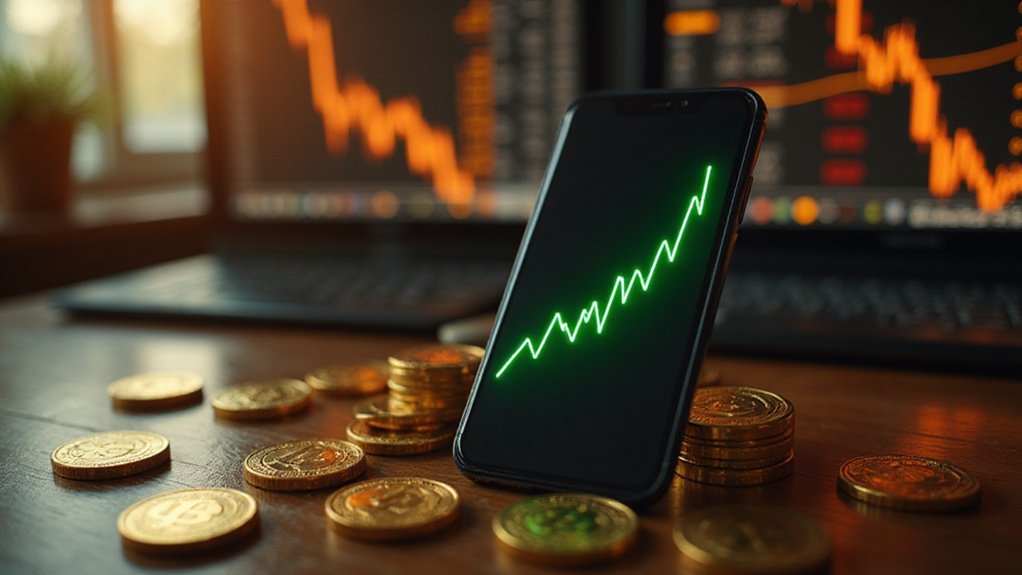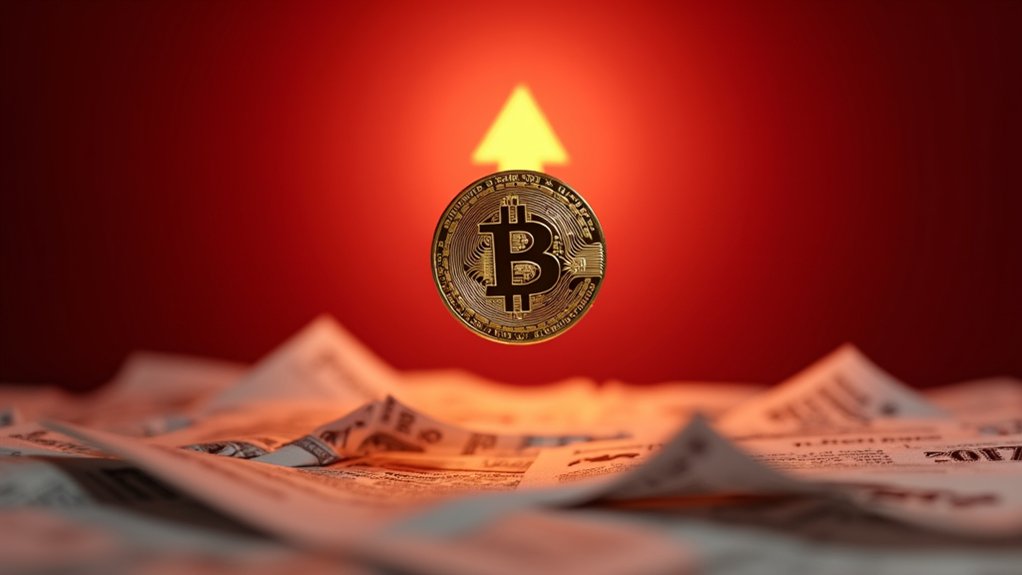DeFi returns have plummeted from $148 per user in 2021 to merely $7.9 in 2024, despite the sector’s explosive growth to $190 billion in total value locked and $438 billion in trading volumes. This paradox reflects how exponential participant influx has fragmented opportunities across proliferating protocols, diluting individual profitability even as sophisticated strategies like yield farming and derivatives trading emerge. The mathematics of collective prosperity versus personal returns reveals deeper complexities ahead.

The decentralized finance sector in 2024 presented investors with a peculiar paradox: while total value locked soared beyond $190 billion and trading volumes reached stratospheric heights of $438 billion in December alone, the average revenue per user plummeted from $148 in 2021 to a rather modest $7.9.
This seemingly contradictory narrative becomes more comprehensible when examining the underlying mechanics of DeFi’s evolution.
The sector’s maturation brought both sophistication and dilution—more participants chasing returns across an increasingly fragmented landscape of protocols and platforms.
DeFi’s growth paradox: exponential participant influx meeting diminishing individual returns across an ever-expanding constellation of competing protocols.
Ethereum’s commanding $64.5 billion TVL underscored its continued dominance, yet the proliferation of alternative chains meant revenue streams became increasingly dispersed. Ethereum’s 71% TVL increase highlighted its sustained growth despite competitive pressures from alternative blockchain networks.
Yield farming, that quintessentially DeFi pursuit of extracting maximum returns through liquidity provision, maintained its allure despite the broader revenue decline. Participants typically engage in strategies such as providing liquidity to trading pools, where they deposit token pairs and earn fees from trades, though they must carefully consider risks like impermanent loss that can erode profits when token prices diverge significantly.
Average returns per participant exceeded $1,300 in 2024, though such figures warrant scrutiny given the inherent selection bias toward active, capital-intensive participants.
Liquid staking protocols alone commanded $63 billion in Q1, suggesting that sophisticated investors found ways to navigate the yield compression affecting retail participants.
The explosion in derivative DEX trading volumes—from $33.3 billion to $342 billion—revealed where the real action migrated.
Platforms like Hyperliquid, processing up to 100,000 orders per second without traditional KYC requirements, attracted traders seeking both speed and anonymity.
This shift toward derivatives trading represented a maturation of DeFi beyond simple lending and borrowing into more complex financial instruments.
User activity surged 291% quarter-over-quarter, creating an interesting dynamic where participation expanded dramatically while individual returns compressed.
This democratization of access, while philosophically aligned with DeFi’s ethos, inevitably led to returns gravitating toward more efficient market pricing.
Regulatory uncertainty continued casting shadows over the sector’s trajectory, with companies like DeFi Technologies maintaining cautiously optimistic revenue projections of $201.07 million for 2025. The broader market shows global revenue expectations of $376.9 million by 2025, indicating substantial growth potential despite current headwinds.
The fundamental tension between innovation and compliance remained unresolved, creating an environment where returns reflected not just market dynamics but regulatory risk premiums.
Despite compressed individual yields, institutional capital continued flowing into DeFi infrastructure, suggesting that sophisticated investors view current returns as a temporary normalization rather than permanent impairment of the sector’s earning potential.
Frequently Asked Questions
What Are the Tax Implications of Defi Returns in Different Countries?
DeFi taxation varies considerably across jurisdictions, creating a delightful maze for international investors.
The US treats gains as ordinary income or capital gains (10-37%), while the UK applies 10-20% capital gains rates with a £12,000 exemption.
Australia imposes 0-45% depending on income brackets, and Canada levies 0-27% based on provincial variations.
Universally, authorities demand meticulous record-keeping—because nothing says “decentralized finance” quite like thorough government documentation requirements.
How Do Defi Returns Compare to Traditional Savings Account Interest Rates?
DeFi returns dramatically outpace traditional savings accounts, which currently offer modest rates around 0.5-5% annually.
Meanwhile, DeFi platforms generate average user revenues exceeding $1,378—though this figure conflates various activities beyond simple yield farming.
The comparison proves somewhat disingenuous: savings accounts provide FDIC-insured stability, while DeFi delivers volatility-laden returns that can evaporate faster than morning mist.
Risk tolerance ultimately determines whether higher yields justify sleepless nights.
What Happens to My Defi Investments if the Protocol Gets Hacked?
Protocol hacks typically result in partial or complete loss of deposited funds, with investors facing immediate liquidity restrictions and potential token depegs.
Recovery prospects remain dismally low—fewer than half of hacked protocols survive long-term.
Reimbursement depends entirely on protocol treasury decisions and available funds, though most lack formal insurance mechanisms.
The fortunate reality? Audited protocols account for only 14.3% of total losses, suggesting due diligence matters considerably.
Can I Lose More Money Than I Initially Invested in Defi?
Yes, investors can lose more than their initial DeFi investment through several mechanisms.
Leveraged positions amplify losses beyond principal amounts, while flash loan attacks and smart contract exploits can drain entire protocol treasuries—affecting users who provided liquidity or collateral.
Borrowing protocols may liquidate positions at unfavorable rates during market volatility.
Additionally, yield farming strategies involving borrowed funds can create cascading losses that exceed original investments, particularly when protocol vulnerabilities are exploited.
How Often Should I Compound My Defi Rewards for Maximum Returns?
Ideal compounding frequency depends on gas costs versus incremental gains—a delicate balance that separates shrewd operators from fee-bleeding novices.
Daily compounding maximizes mathematical returns but often surrenders profits to transaction costs.
Weekly intervals typically offer the sweet spot, capturing substantial compound growth while avoiding death by a thousand gas fees.
Monthly compounding suits patient investors prioritizing cost efficiency over marginal gains, though missing potential upside during volatile periods.









